Let’s start with the gold-silver ratio and revisit something we said on 23 August…
 Bullion.Directory precious metals analysis 14 September, 2021
Bullion.Directory precious metals analysis 14 September, 2021
By Keith Weiner
CEO at Monetary Metals
“…the supply and demand fundamentals of silver are stronger here than they have been since the Covid crisis.
… physical silver is scarcer than gold.”
This corresponds to the peak where we have drawn an arrow on the gold-silver ratio chart.
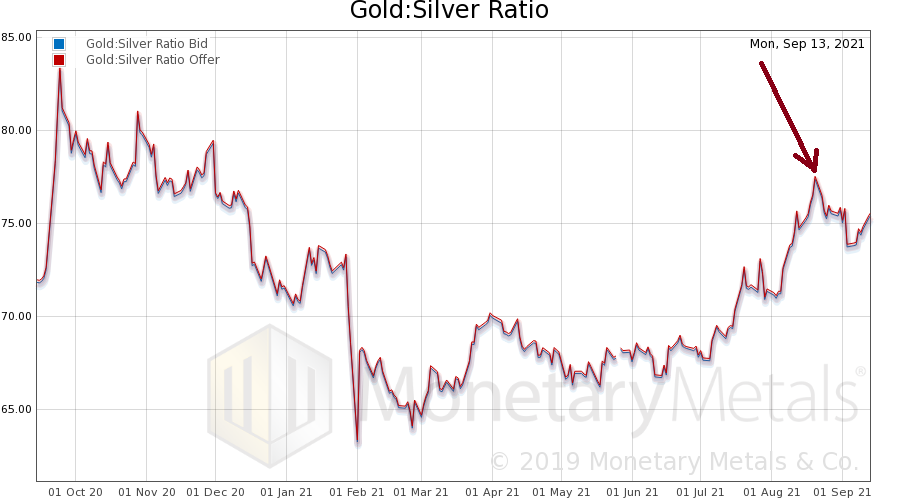
Soon after we said that, the ratio moved down about 5% (i.e. in favor of silver).
And now we see a similar pattern in the ratio of the gold basis to silver basis / gold cobasis to silver cobasis, as we saw on 23 August. The following chart shows the relative abundance / scarcity of the metals.
Gold and Silver Price Fundamentals
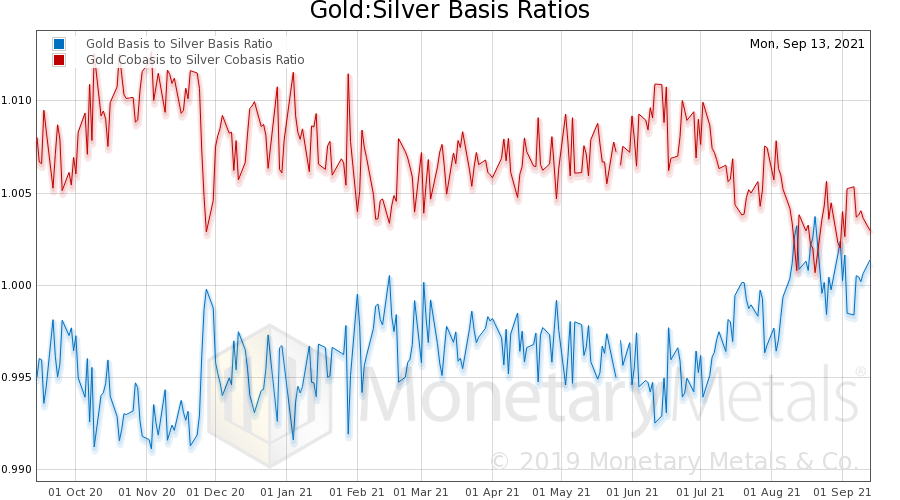
As the ratio of the cobases falls (i.e. gold is becoming less scarce compared to silver), the likelihood of an outsized move in the silver price increases. Of course, the reason why silver is becoming scarcer is that its price is falling more.
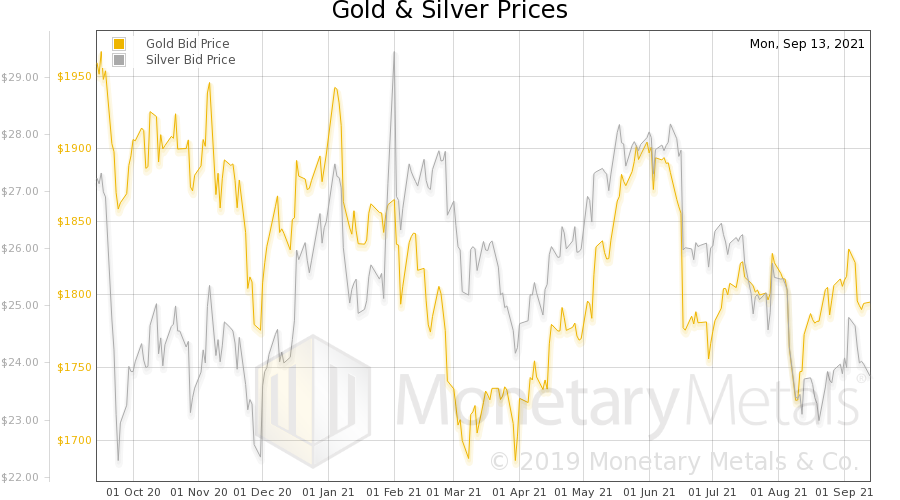
A Recipe for Rising Gold and Silver Prices
There is a pattern we see often in both metals. Price weakness tends to be driven by futures speculators liquidating positions. This means that the metal becomes scarcer.
It stops going into the warehouse (i.e. carry trades, where market makers borrow dollars to buy metal and sell a futures contract against it, to pocket the basis spread). Instead, it can begin coming out if it gets scarce enough. In other words, the marginal source of demand had been the warehouse, but this becomes the marginal supply. A recipe for rising price, especially if buying outlasts the warehouse supply.
NB: we do not refer to the COMEX vault numbers, either “registered” or “eligible”. The amount of gold and silver out there is vastly greater than what is in a few depositories qualified by the futures market.
When decarrying cannot be sustained any more, then the price rises. The speculators—using leverage—can move the price a bit for a while, but soon enough the price is driven by the fundamentals.
This is observed in a distinct falling basis / rising cobasis as the price reaches a low point. The more that the price stretches the fabric of the market to the downside, the more probably that it will snap back.
Gold Price Fundamentals – Gold Basis Analysis
Here is the gold chart, showing the price of the dollar in gold (inverse to the price of gold, in dollars).
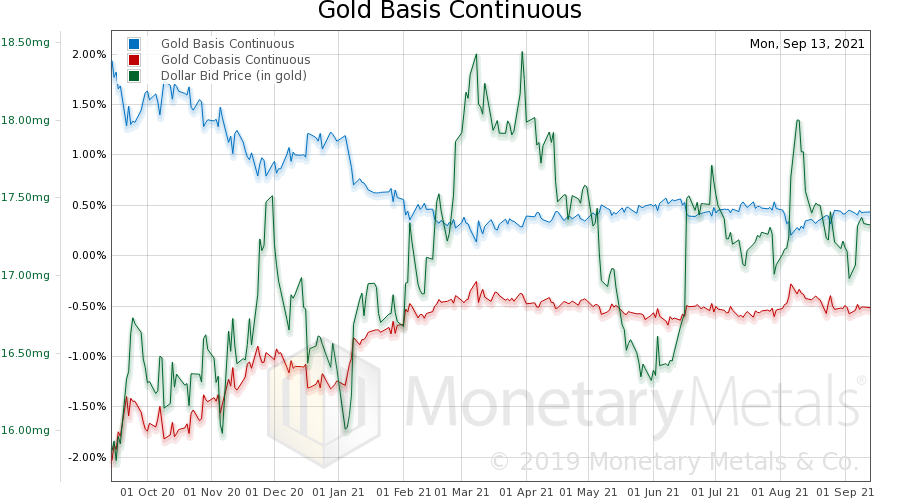
The gold cobasis (scarcity) has been remarkably stable since early February, around the -0.50% line. One of the things that makes the basis a good signal is that it is much more stable than price. Still, this is unusual in that there has been little change even while the dollar moved around from 16.3 to 18.4 milligrams (stated inversely, gold moved around from $1,685 to $1,905).
Perhaps it’s because there is little public excitement about gold. But whatever the reason, buying or selling has been evenly matched in futures and in spot gold. This is why the big price moves caused barely a ripple in the cobasis.
Silver Price Fundamentals – Silver Basis Analysis
Silver, on the other hand, isn’t moving in quite the same way as gold.
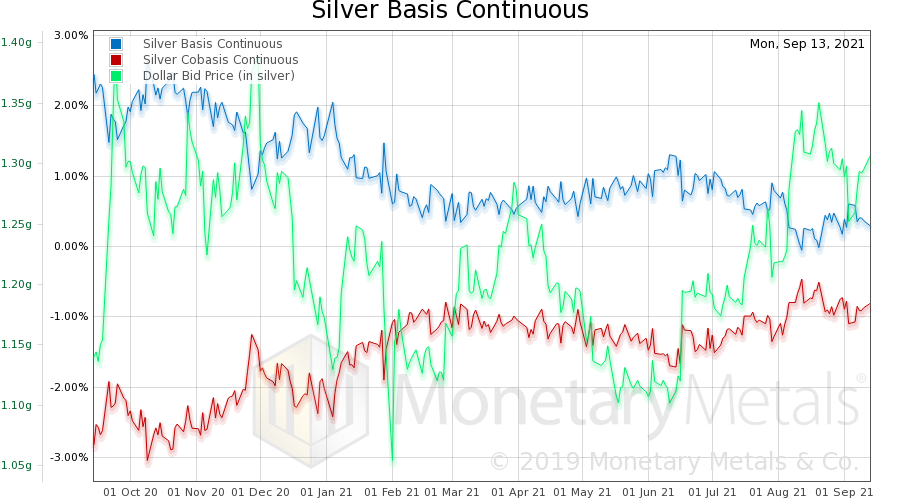
The price swings in silver are much bigger, so the little ripples in the gold cobasis are amplified into peaks and valleys in the silver cobasis (and the absolute magnitude is greater too, as silver’s lower liquidity means wider bid-ask spreads, and hence a higher basis and lower cobasis).
Is this Silver Squeeze Over?
Incidentally, Wall Street Silver began their campaign to “squeeze” silver sometime in January. The price of the dollar in silver terms moved up, then down, then up, and so on). However, the scarcity of silver rose during the most active period of their campaign (with some jitter) from the start of the year through the end of February.
That move in the basis is not correlated with the move in the price. It is a period of gently growing scarcity. After that move was over—presumably the silver traders on the Reddit channel bought as much as they cared to buy—the cobasis moves with the price. Notable, its level remains elevated, as those who bought silver Eagles and small bars probably did not sell the metal back to the market.
Will they? Fundamental analysis is looking at the fundamentals as they exist in the market right now. It is not trying to predict changes that may be psychological, though we can make some inferences.
Buying Silver isn’t Crazy, but this is…
Surely, they will give up on the idea of “squeezing” silver, and realize a monetary metal does not work like a heavily-shorted stock. Or maybe they have already realized that.
But on the other hand, they also probably realize that zero interest-rate policy has made all other asset classes expensive, not to mention subject to increasing credit risk.
Is it extraordinarily for retail investors to have a few hundred ounces of silver coins at home? Historically, not at all. What is extraordinary is that every government in the world is all-in on a mad monetary scheme, desperately trying to prop up their mad fiscal schemes.
There may be price gyrations in the meantime, but at the end of the day those who own gold and silver will be better off than those whose faith is 100% in paper scrip.
Keith Weiner


Keith Weiner is founder and CEO of Monetary Metals, the groundbreaking investment company monetizing physical gold into an interest-bearing asset, paying yields in gold, not paper currency.
Keith writes and speaks extensively, based on his unique views of gold, the dollar, credit, the bond market, and interest rates. He’s also the founder and President of the Gold Standard Institute USA. His work was instrumental in the passing of gold legal tender laws in the state of Arizona in 2017, and he regularly meets with central bankers, legislators, and government officials around the world.
This article was originally published here











 Material provided on the Bullion.Directory website is strictly for informational purposes only. The content is developed from sources believed to be providing accurate information. No information on this website is intended as investment, tax or legal advice and must not be relied upon as such. Please consult legal or tax professionals for specific information regarding your individual situation. Precious metals carry risk and investors requiring advice should always consult a properly qualified advisor. Bullion.Directory, it's staff or affiliates do not accept any liability for loss, damages, or loss of profit resulting from readers investment decisions.
Material provided on the Bullion.Directory website is strictly for informational purposes only. The content is developed from sources believed to be providing accurate information. No information on this website is intended as investment, tax or legal advice and must not be relied upon as such. Please consult legal or tax professionals for specific information regarding your individual situation. Precious metals carry risk and investors requiring advice should always consult a properly qualified advisor. Bullion.Directory, it's staff or affiliates do not accept any liability for loss, damages, or loss of profit resulting from readers investment decisions.

Leave a Reply